“The Church would look foolish without them…”
Lay People and Catholic Life in the Archdiocese of Milwaukee
The renewed ecclesiology (theology of the church) of Vatican II has re-focused church history around the “people in the pew.” Laypersons, i.e. those who were not in Holy Orders or who had the vows of religion—were the primary source of Catholic visibility and organization—if there were no people, there would be no Church. Laypersons, working with clergy and religious, formed parishes, schools, health care facilities, social and cultural organizations, and prayer groups. They provided the resources, financing, and physical labor that raised and sustained the Catholic presence in Wisconsin. While it is impossible, however, to think of these activities apart from the church’s sacramental system: the Mass, confession, and public piety which in the Catholic tradition required the ministry of priests and deacons, and the service of professed religious, lay persons are the reason for the church. Indeed, as Cardinal Newman observed, “the Church would look foolish without them.”
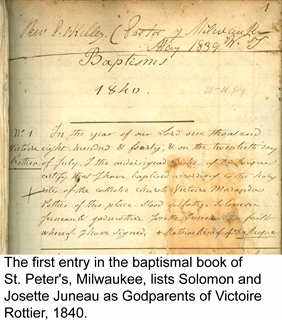 Laymen accompanied early Catholic missionaries to Wisconsin. Priests were scarce and religious practices were often done in the home—reading prayers from manuals of devotion, saying the rosary. Until priests and religious came to stay permanently, lay persons kept Catholicism alive on the frontier. Laypersons were anxious for the creation of chapels and churches and often donated land and materials for early Catholic worship sites. For example land owners like Solomon Juneau (one of the founders of Milwaukee) and his wife Josette deeded property to the church to erect a church in the growing city. Throughout the history of the archdiocese, generous lay benefactions of land and money were critical to the establishment of churches, convents, and religious houses. Devout lay people in Europe donated substantially to the creation of the church in the US—including here in Wisconsin.
Laymen accompanied early Catholic missionaries to Wisconsin. Priests were scarce and religious practices were often done in the home—reading prayers from manuals of devotion, saying the rosary. Until priests and religious came to stay permanently, lay persons kept Catholicism alive on the frontier. Laypersons were anxious for the creation of chapels and churches and often donated land and materials for early Catholic worship sites. For example land owners like Solomon Juneau (one of the founders of Milwaukee) and his wife Josette deeded property to the church to erect a church in the growing city. Throughout the history of the archdiocese, generous lay benefactions of land and money were critical to the establishment of churches, convents, and religious houses. Devout lay people in Europe donated substantially to the creation of the church in the US—including here in Wisconsin.
In 19th century Wisconsin, communities of lay men and women, separated by gender, formed brother and sisterhoods to 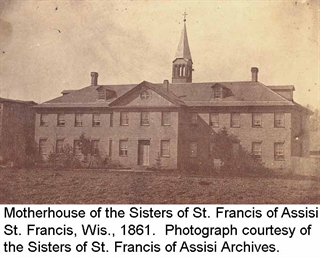 pray and work together in a common life. In St. Francis, brothers and sisters from Ettenbeuren settled and developed property that became the site of St. Francis de Sales Seminary and the Motherhouse of the Sisters of St. Francis. In 1854 at St. Nazianz, Wisconsin, a lay community led by a German-speaking priest, Father Ambrose Oschwald, founded a commune where they lived a religious life as they farmed. This community was eventually taken over by the Salvatorian Fathers and Brothers.
pray and work together in a common life. In St. Francis, brothers and sisters from Ettenbeuren settled and developed property that became the site of St. Francis de Sales Seminary and the Motherhouse of the Sisters of St. Francis. In 1854 at St. Nazianz, Wisconsin, a lay community led by a German-speaking priest, Father Ambrose Oschwald, founded a commune where they lived a religious life as they farmed. This community was eventually taken over by the Salvatorian Fathers and Brothers.
When the Catholic population reached a critical mass temporary churches were built. Later as the population grew in size and financial security, a larger, more permanent church replaced the first structure. Schools were created especially by German-speaking communities. The first schools began with lay teachers (generally women, but also some men) who instructed Catholic youth in very simple surroundings until larger quarters could be had. Ultimately they were supplanted by religious sisters who came to Wisconsin instruct the young. These story of these early Catholic teachers, largely young, unmarried women and men, are and important but overlooked feature of the history of Catholic education in the archdiocese.
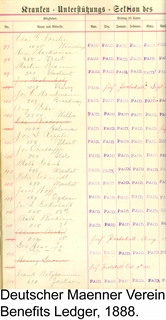 Wisconsin was a land of many peoples: Native Americans, Germans, Irish, immigrants from southern and eastern Europe (especially Poles). The ethnic diversity of the church manifested itself in nationality churches. English speaking (often called Irish) parishes were formed with US born or Irish clergy who spoke English. In these parishes, lay Catholics attended Mass, formed church choirs, and created devotional societies that tended to their needs—and of course supported the erection of buildings with generous donations of money or labor. German parishes did the same and were to be found in every section of Wisconsin. In these communities, German language, spirituality, and cultural heritage were perpetuated. Lay Catholics created a very rich and complex organizational life, forming gender and age specific groups (vereins) that drew together men and women for prayer and mutual support. These groups often sponsored death and burial insurance, offered prayers and support when a member died, and marched in funeral processions. Likewise, these groups, each with their own elaborately crafted banners, marched in public parades for various saints’ days and the Feast of Corpus Christi.
Wisconsin was a land of many peoples: Native Americans, Germans, Irish, immigrants from southern and eastern Europe (especially Poles). The ethnic diversity of the church manifested itself in nationality churches. English speaking (often called Irish) parishes were formed with US born or Irish clergy who spoke English. In these parishes, lay Catholics attended Mass, formed church choirs, and created devotional societies that tended to their needs—and of course supported the erection of buildings with generous donations of money or labor. German parishes did the same and were to be found in every section of Wisconsin. In these communities, German language, spirituality, and cultural heritage were perpetuated. Lay Catholics created a very rich and complex organizational life, forming gender and age specific groups (vereins) that drew together men and women for prayer and mutual support. These groups often sponsored death and burial insurance, offered prayers and support when a member died, and marched in funeral processions. Likewise, these groups, each with their own elaborately crafted banners, marched in public parades for various saints’ days and the Feast of Corpus Christi.
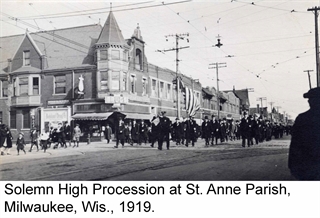 Other nationality groups created these parish-based societies to reinforce ethnic loyalty, provide social insurance, and celebrate saint’s festivals and other religious holidays with pageants, parades, festal Masses, banquets, and supplied color to church dedications, funerals, and other events.
Other nationality groups created these parish-based societies to reinforce ethnic loyalty, provide social insurance, and celebrate saint’s festivals and other religious holidays with pageants, parades, festal Masses, banquets, and supplied color to church dedications, funerals, and other events.
Many of these lay organizations had a long life. For example at Gesu Parish, run by the Jesuits, a branch of the popular Apostolate of Prayer—a specific devotion of the Order to foster devotion to the Sacred Heart, recruited lay persons in a kind of military organization to propagate the saying of the popular Morning Offering. The parish also sponsored the Holy Death Society, a mutual support group (today it might be a called a grief support group) to pray for those who had passed on, offer Masses for the repose of their souls, and provided support in time of need. Other parishes had lay societies to foster devotion to Our Lady of Perpetual Help (a particular devotion of the Redemptorist Order), Our Lady of Pompeii or Our Lady of Light (Madonna del Lume) attracting southern Italians, and devotion to St. Joseph. Lay persons, working with Capuchin and other Franciscans promoted the retreat movement which urged Catholic laymen and women to “come away” for a few days of prayer and reflections.
In 1883, Father Michael McGivney founded the Knights of Columbus, a Catholic fraternal organization (with a woman’s auxiliary called the Daughters of Isabella) which accentuated Catholic loyalty to America. The bonds of fraternalism among Catholic laymen were strongly reinforced by the Knights. The Pere Marquette Council, No. 524 began in Milwaukee in 1900. The Knights also offered insurance policies for members. Their capes, drawn swords, and plumed hats are still a regular feature of archdiocesan and parochial celebrations. Their support of church priorities in the public sphere has been a critical part of Catholicism’s engagement with the wider community.
Other Catholic Fraternals were formed including the Catholic Order of Foresters and the Catholic Knights. The Catholic Knights, today Catholic Financial Life, became very important insurance agents, generous philanthropists, and strong supporters of the local Catholic mission.
Catholics in Publishing
Catholic lay activity was also quite evident in the earliest Catholic press in the archdiocese. Germans took the lead with several papers, most notable Der Warheitsfreund (The Friend of Truth). This paper, founded in 1837and edited by Bishop Henni, had wide circulation in many cities of German-speaking America, and in particular in Milwaukee. Other German Catholic newspapers of note included Der Seebote under layman Peter V. Deuster and Columbia. Both of them served the German Catholic community
Polish Catholics produced their own newspaper, the popular Kuryer Polski in 1883. Founded and edited by layman Michael Kruszka, half-brother of Father Waclaw Kruszka, this paper was a staunch advocate for labor reform, the re-unification of Poland, and insisted on greater Polish leadership in the Archdiocese of Milwaukee. Controversies with church leadership led to the creation of a rival Catholic paper and also a threat to withhold sacramental absolution for anyone who read the paper.
Prominent lay Catholic Humphrey Desmond, lawyer, state legislator and editor, bought the Catholic Citizen newspaper in 1891 and created one of the best national Catholic publications for its time. It was later merged with the archdiocesan Catholic Herald (becoming for a time, the Catholic Herald-Citizen.) Later publications for archdiocesan audiences included the youth magazine Hi-Time, edited by Henrietta Mackin. Ethel Ginthoft became the first lay editor of the Catholic Herald Citizen.
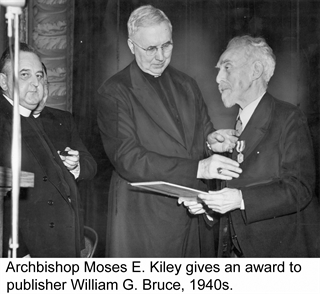 Catholic book publishing became the province of one of the most respected of Milwaukee’s citizens, William George Bruce. A devout Catholic layman, member of Holy Trinity church (to day Our Lady of Guadalupe), Bruce published a popular journal for school boards—among his other public duties. He lobbied hard for the expansion of Milwaukee’s port, good roads, and urban improvement. He was a fixture on the Milwaukee scene until his death in 1949. Bruce’s sons, William and Frank, inherited the publishing business and transformed it into one of the largest Catholic book publishing firms in the world. Catholic books by an array of authors, including Thomas Merton, John Tracy Ellis, and others were produced by Bruce Press.
Catholic book publishing became the province of one of the most respected of Milwaukee’s citizens, William George Bruce. A devout Catholic layman, member of Holy Trinity church (to day Our Lady of Guadalupe), Bruce published a popular journal for school boards—among his other public duties. He lobbied hard for the expansion of Milwaukee’s port, good roads, and urban improvement. He was a fixture on the Milwaukee scene until his death in 1949. Bruce’s sons, William and Frank, inherited the publishing business and transformed it into one of the largest Catholic book publishing firms in the world. Catholic books by an array of authors, including Thomas Merton, John Tracy Ellis, and others were produced by Bruce Press.
Era of Catholic Action
In the early 20th century, Catholics confronted the collective impact of “modernity” which included: economic liberalism, democracy, the free press, the separation of church and state and the dominance of public education. Worried that a rising secularism in the 19th and 20th centuries would further marginalize the church, popes from St. Pius X (1903-1914) down to the present have called for the “rechristianization of the social order” through “Catholic Action.”
In various “Catholic Action” groups, lay men and women resolved to bring Christ back to the marketplace through a variety of organizations. A working definition of Catholic Action was devised early in the 20th century: “the participation of the laity in the apostolate of the hierarchy.” Although this may grate on people’s ears today, it really inspired a good deal of lay activism that had some very powerful impact. Under the leadership of Archbishop Samuel Stritch (1930-1940), Catholic lay activism was organized and coordinated by archdiocesan leadership.
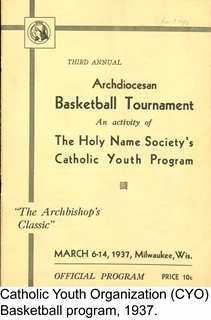 Under the banner of Catholic Action were groups like the Holy Name Society, a fellowship of Catholic men, who joined via their parishes, and who committed themselves to upholding Catholic values in the market place (and also eliminating blasphemous swearing.) Most Milwaukee parishes had Holy Name groups—men who met monthly for a “corporate communion” and the recitation of a pledge. The Holy Name was quite popular: hosting mass prayer rallies, field Masses and sponsoring a popular lecture bureau composed of men from various walks of life. Philip Grau of St. Robert’s Parish coordinated the bureau. Leo Dohn, a parishioner at St. Elizabeth in Milwaukee headed up the archdiocesan Holy Name Union. The Holy Name, for a time sponsored Catholic youth athletics and devotions. Its lecture bureau persisted into the 1960s.
Under the banner of Catholic Action were groups like the Holy Name Society, a fellowship of Catholic men, who joined via their parishes, and who committed themselves to upholding Catholic values in the market place (and also eliminating blasphemous swearing.) Most Milwaukee parishes had Holy Name groups—men who met monthly for a “corporate communion” and the recitation of a pledge. The Holy Name was quite popular: hosting mass prayer rallies, field Masses and sponsoring a popular lecture bureau composed of men from various walks of life. Philip Grau of St. Robert’s Parish coordinated the bureau. Leo Dohn, a parishioner at St. Elizabeth in Milwaukee headed up the archdiocesan Holy Name Union. The Holy Name, for a time sponsored Catholic youth athletics and devotions. Its lecture bureau persisted into the 1960s.
Archdiocesan Conferences of Catholic Men and Catholic Women were umbrella groups that brought together the energies of various Catholic groups in the archdiocese to work for common causes: fund-raising, elimination of pornography, monitoring bad films, and tending to the morality of Catholic youth. The Milwaukee Archdiocesan Council of Catholic Women, founded in 1920, was led for many years by Mrs. James Hackett and later Attorney Katherine Williams, spearheaded many projects, including the Catholic Instruction League—a religious education program for public school youth (mostly Italian youngsters), fund-raising for charities during the Great Depression, mobilizing against divorce, birth control, historic preservation, etc. Williams would lead the national Conference of Catholic Women.
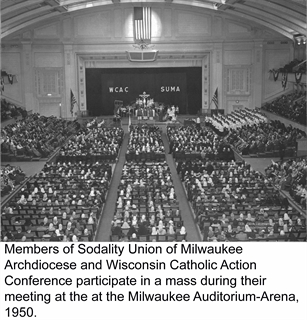 The Sodality of the Virgin Mary, a Marian organization dating back to the 16th century became the special responsibility of the Jesuits. It’s most popular advocate, Father Daniel Lord, SJ, came to Milwaukee frequently and urged that individual Sodality groups be unified under a local umbrella organization. Thus was born in 1930 the Sodality Union of the Milwaukee Archdiocese (SUMA)—probably the most successful youth program in archdiocesan history. Led by Messmer faculty member, Father Louis Riedel, the organization thrived and annually held a wildly popular meeting in Milwaukee—bringing together thousands of Sodalists from all over the state and eventually from all over the Midwest.
The Sodality of the Virgin Mary, a Marian organization dating back to the 16th century became the special responsibility of the Jesuits. It’s most popular advocate, Father Daniel Lord, SJ, came to Milwaukee frequently and urged that individual Sodality groups be unified under a local umbrella organization. Thus was born in 1930 the Sodality Union of the Milwaukee Archdiocese (SUMA)—probably the most successful youth program in archdiocesan history. Led by Messmer faculty member, Father Louis Riedel, the organization thrived and annually held a wildly popular meeting in Milwaukee—bringing together thousands of Sodalists from all over the state and eventually from all over the Midwest.
The Catholic Youth Organization (CYO) was established in the archdiocese in 1934 by uniting the junior members of the Holy Name and Sodality chapters in parishes. Athletic competition among parish-based teams relied on the help coaches and lay leaders working with archdiocesan leaders.
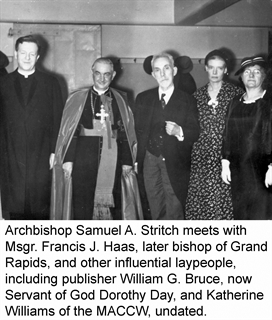 Dorothy Day’s call to radical Catholic living brought the Catholic Worker Movement to Milwaukee in the 1930s. A small House of Hospitality opened in 1936 in the downtown, but closed in the early 1940s. Later, another house of hospitality based on Day’s principles called Casa Maria was founded by Denis and Nettie Cullen in 1966.
Dorothy Day’s call to radical Catholic living brought the Catholic Worker Movement to Milwaukee in the 1930s. A small House of Hospitality opened in 1936 in the downtown, but closed in the early 1940s. Later, another house of hospitality based on Day’s principles called Casa Maria was founded by Denis and Nettie Cullen in 1966.
After World War II, issues of racial justice and concerns about de facto segregation in Milwaukee led to the formation of a branch of the Catholic Interracial Movement with African-American local attorney, James Dorsey as one of its founders. Catholic lay activism in behalf of African Americans was led by the generous benefactions of Harry John and later by the civil rights efforts of Father James Groppi. Groppi was the organizer, but the marchers he led across the 16th street viaduct were mostly lay persons.
Building from the methods and success of Canon Joseph Cardijn of Belgium, Milwaukee welcomed the Specialized Catholic Action Movements in the 1930s: Young Christian Students and Young Christian Workers. Pervasive among religious sisters, seminarians, and youth, and workers these groups met in “cells” to “observe, judge, and act”—bringing Christ into their respective marketplaces. These various movements found encouragement from some priests and sisters. Eventually, priest-leader Father John R. Beix helped find a home for them in an old building on Water Street. This structure was rehabilitated and renamed the “Cardijn Center.” This Center hosted study groups on papal encyclicals (especially Mystici Corporis Christi, Divino Afflante Spiritu, and Mediator Dei), and , encouraged active participation in the liturgy, and urged principles of Catholic social teaching to be implemented at home and in their work place. Later, the Cana Conference and the Christian Family Movement (CFM) also added to the lay directed efforts in the diocese. Offering instruction in marriage preparation and guides for family life, Cana and the CFM were quite popular with lay couples in the archdiocese. The Catholic laity, who participated in the work of this center, were well-prepared for lay leadership in the Catholic Church in the post-Vatican II era.
Although many of its thrusts had been anticipated before, Vatican II implemented a number of reforms that energized the laity in new ways. A new look at the structure of the church, revived the common priesthood of the laity—a feature of baptism: “the primordial sacrament”. Likewise, liturgical reform, which urged full, active, and conscious participation by the People of God, called for an array of liturgical ministers: commentators, lectors, Eucharistic ministers, ministers of hospitality, and others.
Hearing the call to become actively engaged in the ministry of the church, parish life began to percolate with new lay initiatives—parish councils, various committees and an array of men and women who served in various liturgical and catechetical functions. Finance Councils were required for each parish. On the archdiocesan level, lay persons head important offices for the archdiocese: schools, finances, priest personnel, catechetics, social justice, and the chancery. Dr. Barbara Anne Cusack became the first laywoman chancellor in the history of the archdiocese.
Likewise, religious orders of women re-thought their placement policies and often allowed their members to withdraw from school work to other forms of ministry. Lay men and women then were entrusted with the work of perpetuating Catholic education. Today (2018) the majority of teachers and administrators in Catholic schools are laypersons.
Training for these new lay ministries took place at first on an ad hoc basis. In 1972, after much internal debate, the archdiocesan seminary began to admit lay students and then later developed a full-fledged lay formation program. The numbers in this program soon outdistanced the numbers of men studying for the priesthood. Scores of men and women went through the various degree programs and entered the ranks of lay ministers: directors of liturgy, pastoral associates, directors of religious education, and hospital chaplains. Parish directors, a form of administrative leadership of parishes—with an assisting priest—began to be appointed in various parishes in the archdiocese.
Under Archbishop Rembert Weakland, lay preachers were permitted at times to offer reflections on the Word of God during Mass (a task normally reserved for an ordained person). Later, that permission was withdrawn. After concerns were expressed in two papal visitations of seminaries, the Lay Formation program was terminated in 2006 and at the seminary, but was later reopened at Cardinal Stritch University. On-line programs offered by other Catholic institutes also became popular. Lay men and women today head Catholic colleges and universities—jobs once reserved to priests and sisters; are principals of schools, and head bureaus in archdiocesan administration. A number are parish administrators.
This brief essay only scratches the surface of lay involvement and activism in the archdiocese of Milwaukee. Indeed, a whole new historical text is needed to more accurately and fairly recount the work of laypersons in building, sustaining and challenging the Church.
By Rev. Steven Avella
Photographs and documents courtesy of the Archdiocese of Milwaukee Archives, unless otherwise noted. Photographs and documents cannot be reproduced without prior written authorization. For permission to reproduce contact the archdiocesan archives.